The Cub is a cinematic platformer that follows a boy’s race away from interplanetary travelers who try to capture him. It takes place in the post-apocalyptic ruins of Alphaville, a city on Earth that served as a base for launching rockets that carried wealthy and influential people to safety on Mars following a planetary ecological disaster. The rest of humanity was abandoned to die in the toxic atmosphere, leaving only a few surviving children to be literally raised as wolf cubs in the forest surrounding the city. The cub’s chase takes them across these ruins, away from the heartless and cruel returning survivors who want to learn how he is able to thrive in the poisoned atmosphere.
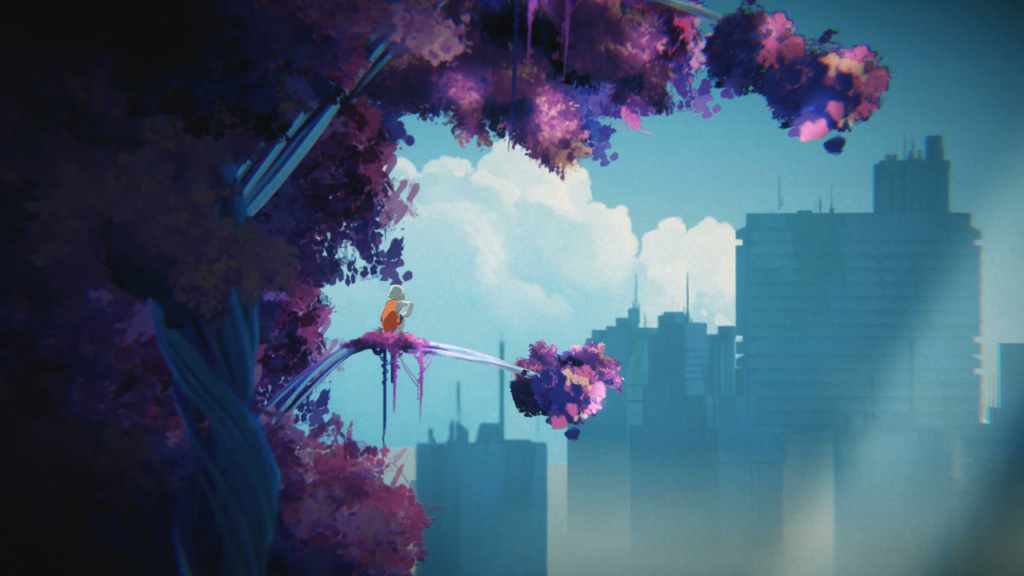
The Cub serves as a semi-sequel to Golf Club Nostalgia, which I reviewed in 2021, and revisits its setting. Many of its images recur as deliberate callbacks, including a pure white giraffe feeding from the roof of a ruined building and a spaceport filled with mountains of abandoned luggage. The more significant aspect The Cub shares with Golf Club Nostalgia is its critical political perspective, though the leftist views expressed in the earlier videogame are magnified and clarified here with greater fury and clearer targets.
As the cub races through eight different chapters, they find discarded newspapers that give me glimpses at the situation in Alphaville before society collapsed. An early headline mentions a CEO named Jeff Bozo. Another describes a government office redefining a hurricane to avoid paying for damages, which turns my mind to a former President of the United States who used a marker to extend a hurricane’s path on a map because his initial prediction was wrong.
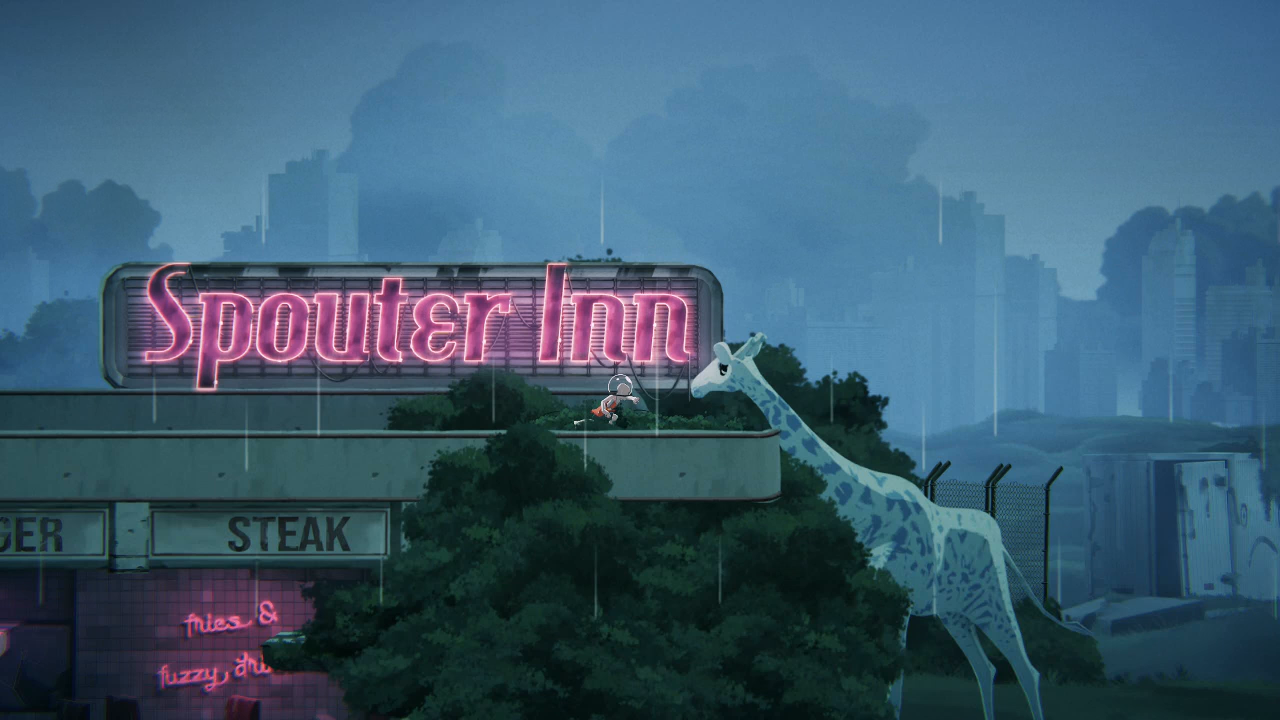
None of Alphaville’s leaders are as prominent in its collected texts as a man named Muskovitch. A supposed engineer and futurist, he claims his reusable rockets will be used to ferry as much of humanity as possible to safety on Mars. The rockets make only one trip before humanity succumbs to the toxic atmosphere, carrying only the wealthiest and most elite to their new home. These survivors declare themselves to be Martians to distance themselves from their actions which doomed their former home. The rockets’ reusability is exploited to gather resources from Earth and to bring Martian tourists who play golf in the ruins. It is one of these expeditions that encounters the cub at the story’s beginning and begins their chase.
Most of The Cub’s platforming is spent on chase sequences through some kind of crumbling or overgrown environment. The obstacles that hinder the player character’s path from the left side of a level to its right vary. In the overgrown jungle, he must leap across rubble suspended by vines while avoiding giant snakes that twist around the trunks of trees, eager to snap up a tasty child meal. Later, he falls into a dilapidated mine and races on carts along disintegrating tracks. A similar situation finds the cub clinging to the backs of stampeding buffalo, leaping between them before they buck him off and he is trampled beneath their feet.
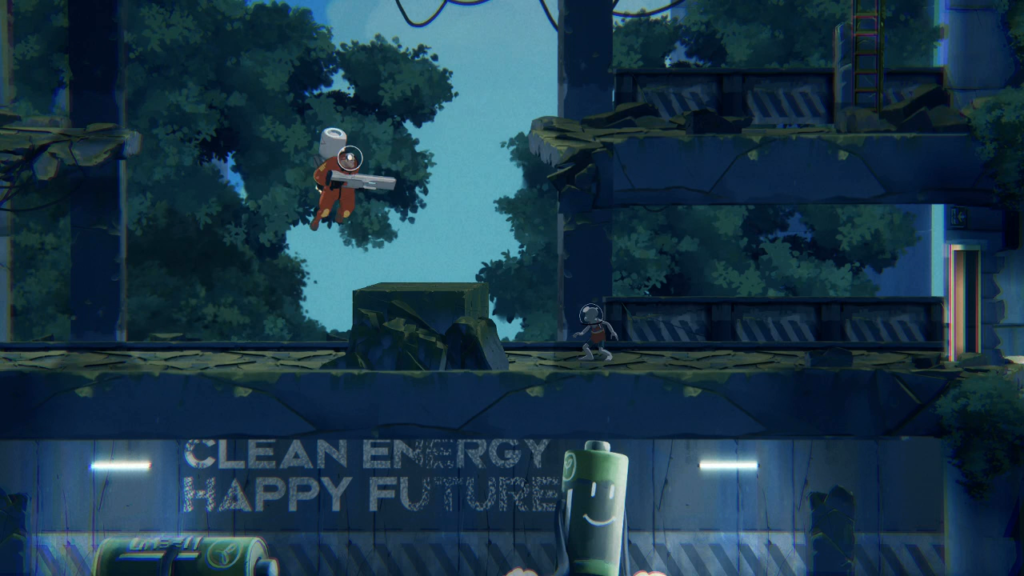
In many of these situations the cub is pursued by the Martian expedition. Each member uses a different method of pursuit that creates a different style of level. One hovers in the screen’s foreground, firing traps in the cub’s path which wraps him in a net when they are touched. Another Martian takes a blunter approach by chasing after the cub with a net, requiring a carefully timed burst of speed forward to avoid their swing. The last Martian patrols the backdrop in their jetpack, ready to shoot at the cub with a tranquilizing dart gun. These sequences slow the pace down to a tiptoe as the cub is forced to hide behind convenient walls and rubble until the patrolling Martian’s back is turned and he can sneak forward to safety.
As a cinematic platformer, the cub’s movement is necessarily limited. I have little control over their trajectory once their feet leave the ground. During the safer, slower moments when the cub is not immediately in danger, this can make the platforming feel stiff and restricted. An action as simple as hopping between nearby ledges is surprisingly difficult, though there is rarely a fatal consequence for failing. In another platformer, I might spend these idle moments randomly jumping just because it feels good to do so. I never have these moments in The Cub. Jumping here only feels good when it is necessary, when the level is designed for it to happen. At any other time it feels like a mechanism grinding uselessly in an empty space.

The strengths of a cinematic platformer become apparent during the chase sequences. These are frantic and highly scripted—they might even be called cinematic—and follow the cub as they dash across an environment, scrambling up piles of rubble, sliding down steep slopes, swinging from dangling chains and vines, and floating on wind currents using plastic grocery bags. All of his actions are captured in detailed traditional animation.
Chase sequences mandate precisely timed jumps that send the cub diving across gaps just beyond the snapping jaws of an alligator, clambering up ledges away from a charging boar, or leaping over a porcupine-like creature that can explode its crystalline spines like a bomb. The exact distance the cub’s jump will carry them is prescribed, so pressing the button a moment too soon or too late will send them to a grisly death or into the clutches of the Martians. Luckily, respawns are quick and checkpoints are plentiful.
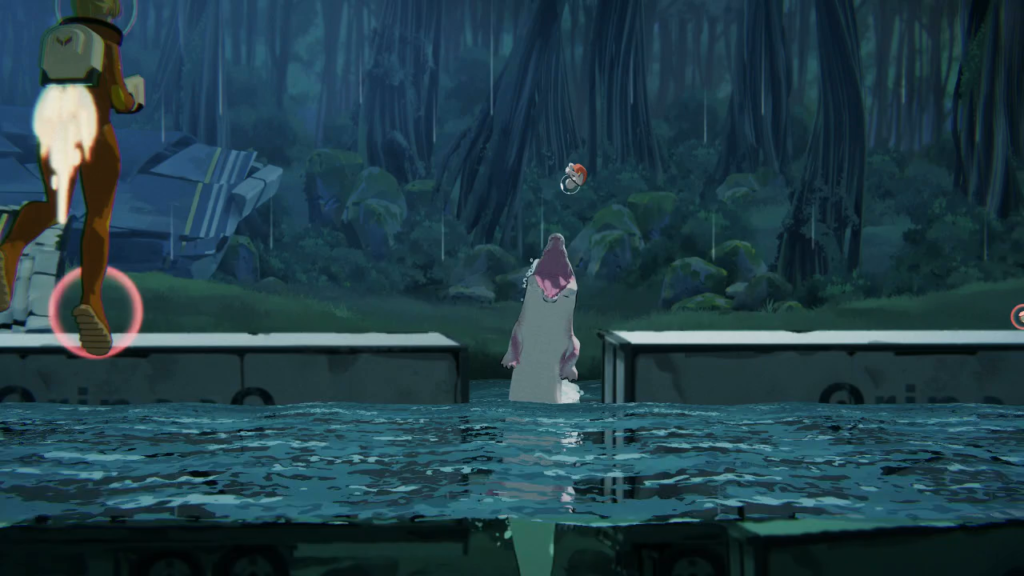
This prescribed timing turns each chase into a kind of rhythm-based puzzle. With enough practice and knowledge, I could guide the cub across each chapter with my eyes closed, guided only by the exact jump timing demanded by the level design. All these events are kept running at high energy, either because the cub is forced by the environment to keep moving forward, or because a pursuing Martian means that slowing for even a moment will result in his capture.
Often while the cub is making one of these leaps, a disconcerting error will occur. Somewhere in the videogame’s processes, how it understands the player character is moving and how that movement is rendered on the screen is disconnected. The cub appears to teleport, disappearing at the end of their jump and then reappearing a moment later several feet away on the platform they were meant to land on. In a platformer that utilizes detailed animations and precise, fluid movement, for the player character to suddenly blink in and out of existence is disorienting. It makes me remember for a moment that I am playing a fallible videogame. It’s easy to forget by shrugging and returning my focus to the next obstacle, but I cannot ignore when it happens again a few minutes later, and then a few minutes after that, and on and on.
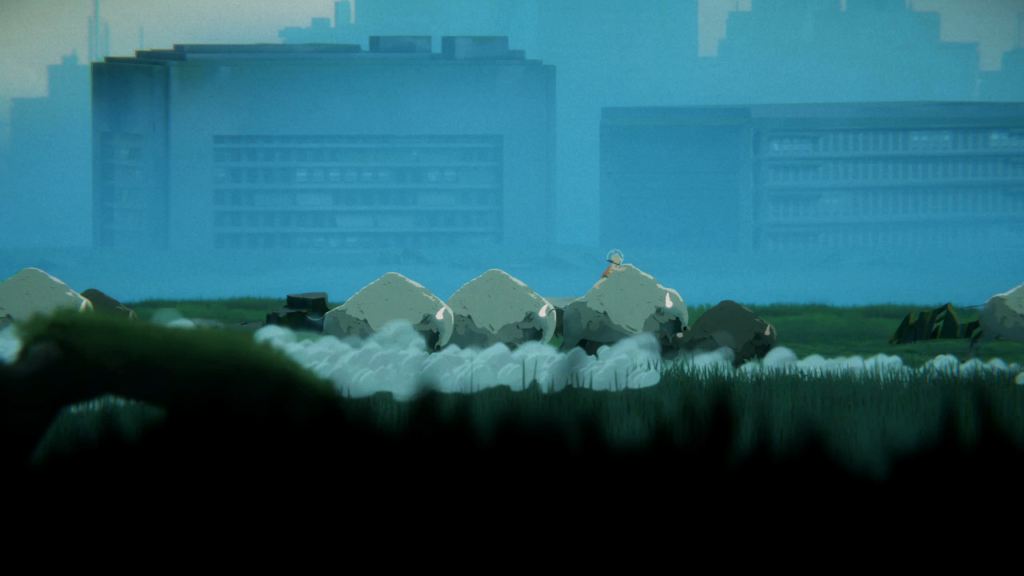
It takes me less than three hours to complete the cub’s race away from his Martian pursuers. If the overprescribed fast-paced platformer pockmarked by occasional animation errors don’t entice me to return for repeat visits, then the best reason The Cub offers is its collectibles. They are mostly found in small enclaves the cub stumbles into between chase sequences. I know when they enter a small building with several floors covered in objects marked by white highlights that for a few minutes the action has come to a stop. The cub can use this break to snoop through humanity’s wreckage.
Most collectibles are found in clusters in these break rooms. Others are found alone in random spots along the cub’s route. Tracking them all down is a chore with dubious returns. To make gathering them still more annoying, collectibles are not maintained between checkpoints. At a few points in my efforts, I get stuck on a particular sequence immediately following a small group of collectibles. Every time I fail that sequence, I have to guide the cub around the space gathering every shiny object again if I want them to count for my overall progress.
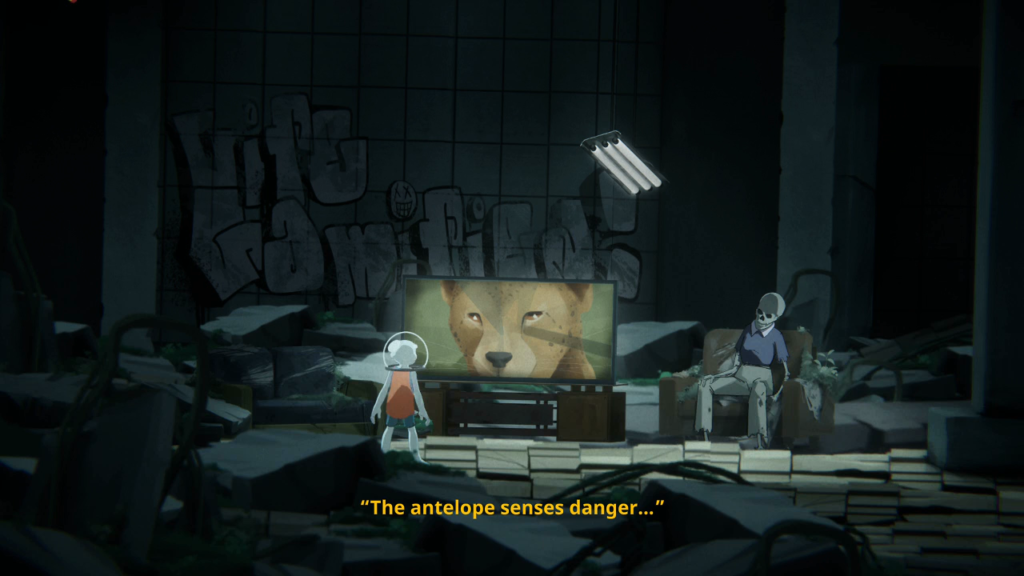
Collectibles add varying amounts of substance to The Cub. The many books, newspapers, and fragments of computer documents offer clues about Alphaville’s collapse. Many others are divided into categories with whimsical names but provide no greater meaning to the story. “Burps” are different kinds of food, appearing as wild berries growing in a thicket of trees as often as a bag of candy found in a shattered vending machine. Examining shattered screens found in buildings adds “Videos” to the cub’s collection, each depicting a few seconds of a show or movie. None of these add greater context to Alphaville’s collapse or the cub’s chase. They are videogame collectibles meant for one hundred percent completion. I feel no compelling reason to find them all.
In my review for Golf Club Nostalgia, I lamented its latter parts when I felt a plot was being unnecessarily imposed on its player character’s peaceful golf game through the horrifying wreckage of human civilization. I feel a similar sense of frustration about The Cub. Its politically left viewpoint is more pronounced and more angry than Golf Club Nostalgia’s, and it uses that anger to literally shout condemnations at those responsible in the climax. It doesn’t fill me with catharsis.
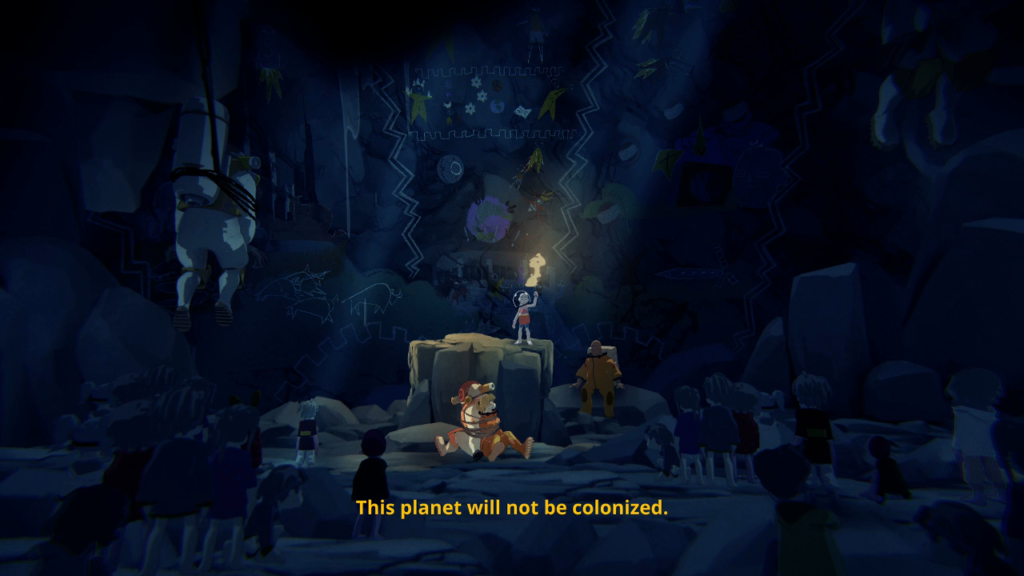
The cub’s primal fury is borne from its inexplicable ability to survive the poison that caused their pursuers to flee Earth and become Martians, poison that would kill them or me or you. It’s a message shouted at all of us from no one for destroying a planet they will never inherit. It’s satisfying only for those who think anger is an accomplishment unto itself, a place to wallow in self-indulgent misery, and not a path to something better. The Cub has many targets to shout at but nothing of interest to be heard.
On a more positive note, The Cub does bring back my favorite element from Golf Club Nostalgia. Shortly after completing a few tutorial screens, the cub discovers a Martian’s corpse, mummified in his space suit. With monkey-like curiosity, the cub removes the Martian’s helmet and puts it on his own head, and instantly the Radio Nostalgia from Mars radio station is transmitted to me through the player character’s ears.
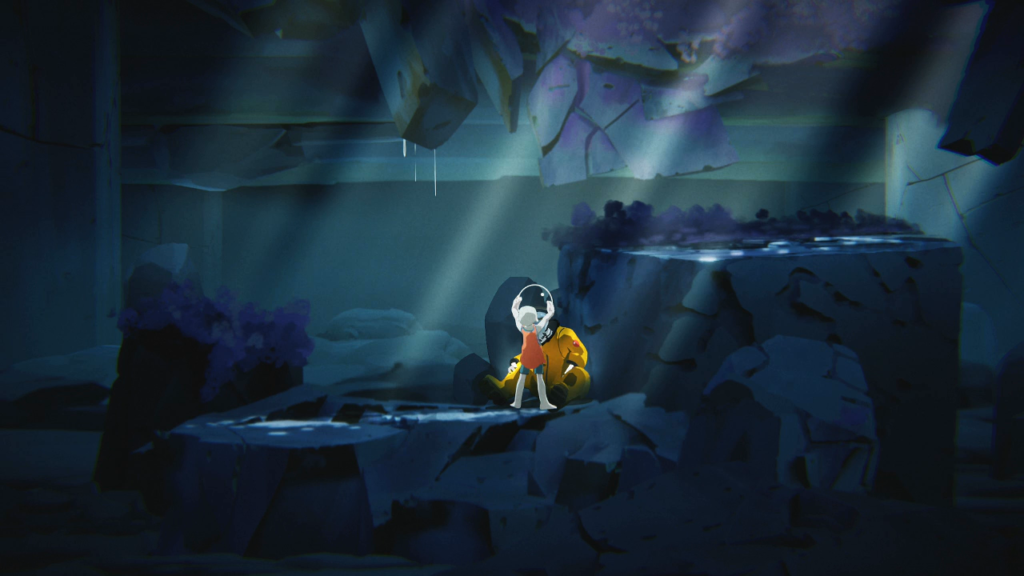
Everything that made Radio Nostalgia from Mars great in Golf Club Nostalgia is repeated here. It has the style of a public radio broadcast, complete with a DJ who hosts the show in a gentle, dull tone. At times he introduces other Martians who tell stories about their lives on Mars, each story tinged with subtle guilt they cannot quite bring themselves to confront. Much of the broadcast is also made up of eclectic music tracks from genres like Psychedelic Rock, Psychedelic Jazz, Trip Hop, and EDM. Some songs are integrated naturally into the broadcast. Others create an ironic soundtrack to the events of the current level.
In Golf Club Nostalgia, the radio station is a constant companion that follows its player character from the beginning of their journey to the end. Frustratingly, the same is not true in The Cub. The broadcast is frequently interrupted by the events of the plot; the signal cannot penetrate into underground areas like the Mines, so that level is played with an ambient soundtrack. At another point the cub’s helmet is smashed, depriving me of the broadcast until he finds another.
These constant interruptions make it difficult to enjoy what sounds like another stellar collection of faux-radio shows broadcasting from a fictional Mars. Thankfully, I can listen to all eight episodes from the main menu whenever I like this time around.
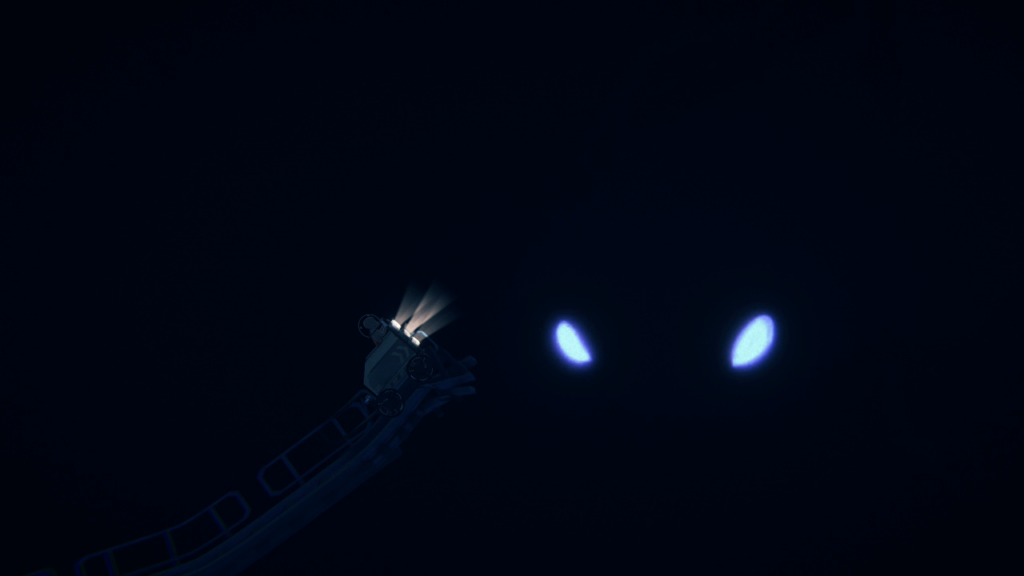
I didn’t expect to ever see a sequel to Golf Club Nostalgia, so I am glad to play another videogame that expands upon its interesting setting. I am disappointed to find that videogame is not particularly fun, memorable, or effective as a platformer. I am also let down that its more overt political messaging culminates in a child’s murderous temper tantrum instead of a righteous call to action. At least the fantastic Radio Nostalgia from Mars is back, though its frequent plot-induced interruptions makes me wonder if its creators might find their talents better used in making for-profit podcasts. The Cub is an inconsistent and sometimes stultifying experience.